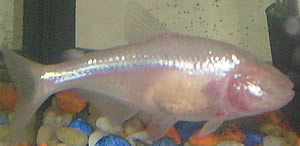
Research suggest that blind Mexican cave fish have undergone multiple evolution events. credit wikipedia
Blind Mexican cavefish (Astyanax mexicanus) have not only lost their sight, but have adapted to perpetual darkness by also losing their pigment (albinism) and having altered sleep patterns. Research led by New York University biologists shows that the cavefish are an example of convergent evolution, with several populations repeatedly, and independently, losing their sight and pigmentation. Their study appears in BioMed Central's open access journal, BMC Evolutionary Biology.
The blind cavefish and the surface dwelling Mexican tetra, despite appearances, are the same species and can interbreed. The cavefish are simply a variant of the Mexican tetra, albeit ones adapted to living in complete darkness. A team of researchers from Portugal, the United States, and Mexico studied the DNA from 11 populations of cavefish (from three geographic regions) and 10 populations of their surface-dwelling cousins to help understand the evolutionary origin of the physical differences between them.
While results from the genotyping showed that the surface populations were genetically very similar, the story for the cave populations was very different. The cave forms had a much lower genetic diversity, probably as a result of limited space and food. Not surprisingly, the cave populations with the most influx from the surface had the highest diversity. In fact, there seemed to be a great deal of migration in both directions.
It has been thought that, historically, at least two groups of fish lived in the rivers of Sierra de El Abra, Mexico. One group originally colonized the caves, but became extinct on the surface. A different population then restocked the rivers and also invaded the caves.
Richard Borowsky, from the Cave Biology Group at NYU and one of the paper's co-authors, explained, "We were fortunate in being able to use A. mexicanus as a kind of 'natural' experiment where nature has already provided the crosses and isolation events between populations for us. Our genotyping results have provided evidence that the cave variant had at least five separate evolutionary origins from these two ancestral stocks."
Martina Bradic, an NYU postdoctoral fellow who led the research, conducted the study as part of her graduate work.
"Despite interbreeding and gene flow from the surface populations, the eyeless 'cave phenotype' has been maintained in the caves," she said. "This indicates that there must be strong selection pressure against eyes in the cave environment. Whatever the advantage of the eyeless condition, it may explain why different populations of A. mexicanus cave fish have independently evolved the same eyeless condition, a striking example of convergent evolution."
- "Gene flow and population structure in the Mexican blind cavefish complex" (Astyanax mexicanus) Martina Bradic, Peter Beerli, Francisco García-de León, Sarai Esquivel-Bobadilla, and Richard Borowsky BMC Evolutionary Biology (in press)
